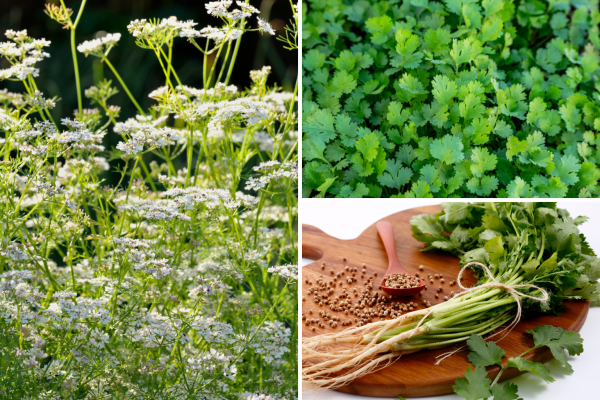
Cilantro / Coriander (Coriandrum sativum) Datasheet
Common Name: Cilantro (leaves), Coriander (seeds)
Scientific Name: Coriandrum sativum
Family: Apiaceae
Origin: Eastern Mediterranean and Southern Europe
Zone Hardiness: USDA Zones 2–11
Light Requirements: Full sun to partial shade; requires 6–8 hours of sunlight daily
Water Needs: Moderate; approximately 1 inch (2.5 cm) per week
Soil Preferences: Well-drained, fertile loamy or sandy soil with pH between 6.2 and 6.8
"Ponics" Compatibility:
-
Aquaponics: Fairly compatible
-
Aeroponics: Fairly compatible
-
Hydroponics: Fairly compatible
-
Preferred Method: Deep Water Culture (DWC) and Nutrient Film Technique (NFT); requires temperature control to prevent bolting
Growth Habit: Upright annual herb
Height & Spread: Height: 10–24 inches (25–60 cm); Spread: 8–12 inches (20–30 cm)
Time from Germination to Harvest: Leaves: 30–45 days; Seeds: 90–120 days
Flowering Time: Late spring to early summer
Edible Parts: Leaves, stems, seeds, and roots
Medicinal Uses: Traditionally used to alleviate gastrointestinal discomfort, respiratory issues, and urinary complaints
Companion Plants: Legumes (e.g., beans, peas), potatoes, and lupines
Pest & Disease Resistance: Susceptible to aphids and fungal diseases like Septoria leaf spot; crop rotation and proper spacing recommended
Harvest Time: Harvest leaves before flowering; seeds when they turn brown. Store leaves in a jar with water in the refrigerator for up to a few days; seeds can be dried and stored in airtight containers
Propagation Methods: Primarily by seed; seeds germinate in 7–21 days. Direct sowing recommended due to sensitivity to transplanting
Sustainability Features: Attracts beneficial insects; can act as a trap crop for aphids; contributes to soil health when used in crop rotation
Culinary Uses: Leaves used in salsas, curries, and salads; seeds used in spice blends, pickling, and baking; roots used in Thai cuisine
Fun Fact: Coriander seeds are one of the key botanicals used to flavor gin
Santo (Coriandrum sativum 'Santo')
-
Flavor Profile: Classic cilantro flavor with a hint of citrus.
-
Culinary Uses: Widely used in Mexican and Asian cuisines; leaves for fresh dishes, seeds for spices.
-
Notes: Slow to bolt; suitable for warmer climates.
Calypso (Coriandrum sativum 'Calypso')
-
Flavor Profile: Mild and sweet.
-
Culinary Uses: Ideal for salads and garnishes.
-
Notes: Slow-bolting variety; good for extended leaf harvest.
Confetti (Coriandrum sativum 'Confetti')
-
Flavor Profile: Milder than common cilantro.
-
Culinary Uses: Decorative garnishes; subtle flavor addition.
-
Notes: Finely divided, dill-like foliage; unique appearance.
Delfino (Coriandrum sativum 'Delfino')
-
Flavor Profile: Similar to standard cilantro.
-
Culinary Uses: Garnishes and salads.
-
Notes: Fern-like leaves; ornamental appeal.
Leisure (Coriandrum sativum 'Leisure')
-
Flavor Profile: Traditional cilantro taste.
-
Culinary Uses: Versatile; used in various dishes.
-
Notes: Slow to bolt; reliable for continuous harvest.
Long Standing (Coriandrum sativum 'Long Standing')
-
Flavor Profile: Robust and aromatic.
-
Culinary Uses: Suitable for cooking and fresh use.
-
Notes: Resists bolting; extended harvesting period.
Marino (Coriandrum sativum 'Marino')
-
Flavor Profile: Spicy and intense.
-
Culinary Uses: Adds depth to dishes.
-
Notes: Strong leaf growth; high yield.
Moroccan (Coriandrum sativum 'Moroccan')
-
Flavor Profile: Bold and citrusy.
-
Culinary Uses: Common in Moroccan cuisine.
-
Notes: Early flowering; good for seed production.
Pokey Joe (Coriandrum sativum 'Pokey Joe')
-
Flavor Profile: Rich and complex.
-
Culinary Uses: Enhances flavor in various recipes.
-
Notes: Slow to bolt; rare variety.
Rak Tamachat (Coriandrum sativum 'Rak Tamachat')
-
Flavor Profile: Mild and pleasant.
-
Culinary Uses: Suitable for fresh consumption.
-
Notes: Large leaves; collected from Thailand.
Standby (Coriandrum sativum 'Standby')
-
Flavor Profile: Traditional cilantro flavor.
-
Culinary Uses: Versatile in cooking.
-
Notes: Cold-hardy; suitable for fall sowing.
Sunmaster (Coriandrum sativum 'Sunmaster')
-
Flavor Profile: Classic cilantro taste.
-
Culinary Uses: Used in various cuisines.
-
Notes: Heat-tolerant; slow to bolt.
Caribe (Coriandrum sativum 'Caribe')
-
Flavor Profile: Strong and pungent.
-
Culinary Uses: Ideal for robust dishes.
-
Notes: High leaf yield; vigorous growth.
Dwarf Lemon (Coriandrum sativum 'Dwarf Lemon')
-
Flavor Profile: Lemony aroma.
-
Culinary Uses: Adds citrus notes to dishes.
-
Notes: Compact growth; suitable for containers.
Cilantro Macho (Coriandrum sativum var. vulgare)
-
Flavor Profile: Bold and intense.
-
Culinary Uses: Enhances spicy dishes.
-
Notes: Robust variety; higher heat tolerance.
Coriandrum sativum var. microcarpum
-
Flavor Profile: Traditional coriander seed flavor.
-
Culinary Uses: Seed production; spices.
-
Notes: Smaller seeds; grown in cooler climates.
Coriandrum sativum var. macrocarpum
-
Flavor Profile: Traditional coriander seed flavor.
-
Culinary Uses: Seed production; spices.
-
Notes: Larger seeds; suited for warmer climates.
Vietnamese Coriander (Persicaria odorata)
-
Flavor Profile: Spicy and peppery.
-
Culinary Uses: Common in Southeast Asian dishes.
-
Notes: Not a true cilantro; perennial in warm climates.
Culantro (Eryngium foetidum)
-
Flavor Profile: Stronger than cilantro.
-
Culinary Uses: Used in Caribbean and Asian cuisines.
-
Notes: Heat-tolerant; different species from cilantro.
Papalo (Porophyllum ruderale)
-
Flavor Profile: Bold and complex.
-
Culinary Uses: Mexican dishes; salsas.
-
Notes: Distinct from cilantro; thrives in hot weather.
Audio
Video
